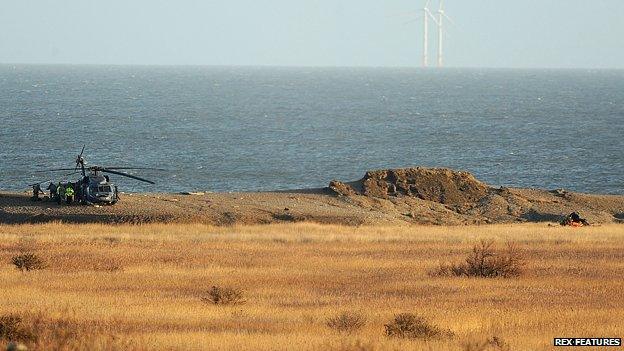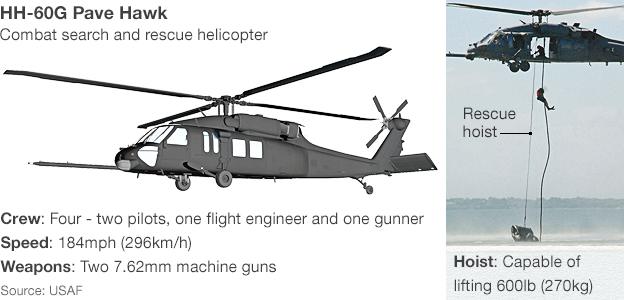Fatal US helicopter crash in Norfolk: Investigation starts
- Published
Aerial footage shows the extent of the damage at the wreckage site, as Simon Newton reports
Investigations have started into the cause of a US Air Force helicopter crash in Norfolk which killed all four people on board.
The HH-60G Pave Hawk, based at RAF Lakenheath in Suffolk, came down at a nature reserve in Cley next the Sea on Tuesday night.
The aircraft, from the 48th Fighter Wing, was on a low-level training mission and carrying live ammunition.
The bodies of the air crew are unlikely to be recovered until Thursday.
The wreckage, including a "significant" number of bullets from the crashed aircraft, is scattered over an area the size of a football pitch, police said.
It will take a number of days to carry out an inquiry, due to the geography of the area and the live munitions.
The public are urged to avoid the site, which lies in marshland between the A149 and the coastline, while emergency services, Ministry of Defence, US Air Force and HM Coroner assess the site.
A 1,200ft (400m) area is cordoned off and the A149 through Cley is closed.
'Difficult terrain'
A second helicopter from RAF Lakenheath, which landed on the marshes shortly after the crash, also remains at the scene.
A large military lorry, loaded with an excavator and what looked like a battery unit has driven to the crash site, BBC reporter Simon Newton said.
Ch Supt Bob Scully, from Norfolk Police, said officers received reports of a helicopter crash "somewhere on the north Norfolk coast" at about 19:00 GMT, and quickly established it was at Cley.
He said the inquiry was being led by police "in situ", with the bodies of the four crew members to be recovered once initial investigations had taken place.
"The crash site is about the size of a football pitch, with difficult terrain which makes this a challenging and lengthy process," he added.
"This is mainly on marshland although some debris which was close to the beach has been moved as it would be vulnerable to high tide.

The scene where a US Pave Hawk helicopter crashed killing four people at Cley next the Sea, Norfolk

The wreckage, near a second US helicopter, is scattered over an area the size of a football pitch, police said
"Further close examinations of the scene will take place this morning and the bodies of the deceased will be removed once this has taken place.
"The helicopter was carrying ammunition this was in the form of bullets which are scattered across the site, which is why the restrictions are necessary.
"We must undertake this investigation and recovery operation in a careful and methodical way so we can provide answers as to why this crash happened.
"For reasons of safety it is essential that members of the public adhere to the cordon."
Military investigators from the US and UK are expected to work together to establish exactly what happened once the police involvement was over, he added.
He described the scene has "hazardous" and said walking and bird-watching in the area would be restricted until the marshland was safe.
Some debris has already been moved to protect it from high tide, he added.
Details of the four crew members will not be released until next-of-kin have been informed, police said.
Col Kyle Robinson, Commander of 48th Fighter Wing, said: "The loss of our Liberty Wing brethren is felt deeply across RAF Lakenheath.
"I can only imagine the hurt and sorrow felt by the family and friends of these airmen. You are in our hearts and minds.
"We're already feeling a great sense of support from across the Air Force and from our UK neighbours as we go through this difficult period."
Bernard Bishop, a Norfolk Wildlife Trust warden based at Cley, said his house overlooked the crash site.
"I heard the helicopter flying overhead and watched from my back garden," he said.
"It was very quickly obvious something serious was wrong. The search and rescue crews quickly arrived and it was my job to escort them over the marsh.


The HH-60G Pave Hawk, a version of the US Army's Black Hawk helicopter, is used by the US Air Force for combat search and rescue, mainly to recover downed aircrew or other isolated personnel in war zones.
The helicopter, made by Sikorsky, has been used in numerous military missions, in Iraq and Afghanistan, as well as civilian rescue operations after disasters like the 2004 Boxing Day tsunami in Sri Lanka and Hurricane Katrina in the US in 2005.
The Pave Hawk, which came into service in 1981, has a four-man crew and can carry up to 12 troops.

"The conditions are very difficult because the marsh has flooded twice in recent weeks so that's hampering their efforts to recover the bodies and make the helicopter safe.
"There's only one track in and out of the crash site, which is also restricting their movements.
"It's just awful. I've never known anything like and never seen so many people here at one time."
Accidents 'rare'
The HH-60G Pave Hawk is a version of the US Army's Black Hawk helicopter and is used for combat search and rescue, mainly to recover downed aircrew or other isolated personnel in war zones.
Eyewitness Brian Egan recorded footage of the helicopter "flying low" before the crash
It is more than 17m long (nearly 65ft) and has a maximum speed of 224mph.
The 48th Fighter Wing, also known as the Liberty Wing, is assigned to the United States Air Forces in Europe.
Retired USAF colonel Rick Davis told BBC Breakfast the unit was tasked to be "combat-ready" and must be ready to deploy anywhere in the world within 72 hours.
Aviation expert Chris Yates told the BBC's Today programme: "This area of the country has lived with military operations for an awful lot of years, and it's rare for accidents such as this to happen.
"We have to be mindful that these are military flyers and they are the best, of the best, of the best.

"It would be unusual, once we get through this investigation, to find that this was pilot error; it might be more mechanical fault."
Cley is one mile east of Blakeney and four miles north of Holt, on the main coast road between Wells and Sheringham.
The village's nature reserve is famous as a bird-watching site.
- Published8 January 2014
- Published8 January 2014
- Published7 January 2014
- Published7 January 2014